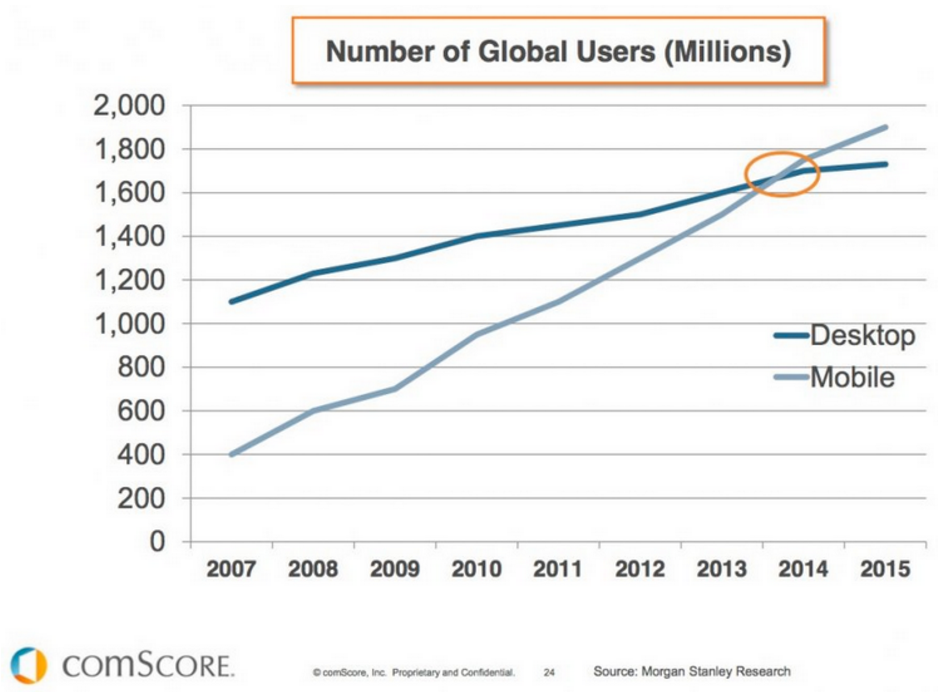6 digital trends of 2016: are you lagging behind?

You don't have to be an expert to notice that social media is evolving. Sometimes it's truly hard to tell which changes are important for business purposes and which are important for your kid's selfie habits. Here I've gathered trends (some of which have been trends for the past couple of years, some of which are just rising) that you should take into account when building your digital marketing strategy.
1. Social media morph into search engines
Image source: WordStream
Do you remember this time when scrolling through Facebook meant looking at your friends’ posts and photo albums? And nothing more?
For the better or worse, these times are long gone. People now use social networks as search engines to look for any content they are interested in. There is a good reason for this shift: all kind of content is now on social media.

What does it mean for businesses?
Content is still everything. By no means should you decrease your content marketing efforts. And, of course, all your content should live on social media. Same goes for your company's news, releases, updates, etc. If you have anything to say - say it on social media, not on your personal website.
What should you say?
80% of business decision-makers prefer to get company information in a series of articles versus an advertisement, and 78 percent believe that organizations providing custom content are interested in building good relationships with them. So make an effort to create custom and valuable content for your audience. Think about what your target audience searches for in your niche. For example, if you sell slow cookers, they are probably interested in recipes. It would be a good idea to start posting some on social network pages. Think about any "How to" and "FAQ" posts. Think assisting, not selling. 
How should you say it?
Another important current trend is visual content. As you might've heard, YouTube is the second largest search engine. Instagram and Pinterest are on the rise. The reasons for that are simple and purely scientific. We know that visuals increase people's willingness to read a piece of content by 80%, and shoppers who view video are 1.81X more likely to purchase than non-viewers. So if possible in your business, make sure a lot of your content is posted in the form of photos or videos.
2. Real-time engagement

Engagement has been a key way to advertise to millennials for some time now. There is a number of good reasons for that, with the main one being that nothing else works well. Millennials are too tech-savvy for online ads: they skip them before watching the video, and install ad blockers. However, that doesn't mean millennials hate brands - they just prefer marketers to talk with them as opposed to at them. According to Forbes, “62% of millennials say that if a brand engages with them on social networks, they are more likely to become a loyal customer. They expect brands to not only be on social networks but to engage them.” The key trend of 2016 is that marketers have to engage in real time.
Social media has never enjoyed any kind of delay much. People that are online but take hours to reply make all of us furious. With time, social media’s instant nature has become more and more, well, instant. Surveys go out of their way to show how little patience internet users have. A page takes more than two seconds to load? Forget it. A brand takes more than an hour to reply to your Twitter complaint? Never going to buy their chocolate bar again. And so on. I am not exaggerating: Search Engine Watch showed that 72% of users expect a brand to reply to their Twitter query in under an hour. Who has ever expected such effective communication from emails?
And social media hasn’t stopped (and won’t stop) at that. Apps such as Snapchat and Periscope (instant disappearing photos and live videos accordingly) appeared as a next step in the real-time social media evolution and got very popular very quickly. Snapchat is a 3rd most popular social media platform among 18-34-year-olds according to Comscore report.
What does it mean for businesses?
First and foremost, it means that there is no way around real-time engagement. The demand for businesses to increase response times won’t disappear - it will increase. Yet, as for now, many brands are behind in adapting to the social media trends. In 2015, 7 in 8 messages to brands went unanswered within 72 hours. This is a good opportunity to show how you're better than your competition and show off excellent customer service. Of course, this isn’t done manually, this would be impossible - Awario and similar social monitoring tools are used for real-time engagement.
Second, starting with real-time marketing on social media may be a very good idea if compatible with your business. For example, Unique Cosmetics uses Facebook live videos to show off new products, ways to apply makeup, and anything else they deem relevant. This is quite different from filming and posting the video later on and seems to be more personal and entertaining to people.
3. Mobile

Not so long ago mobile devices have taken over desktop as the most popular way to browse the Internet. Today, mobile digital media time in the US is significantly higher than that of a desktop (51% mobile vs 42% desktop). This isn’t surprising, considering that 80% of Internet users own a smartphone. Besides, don’t forget tablets. Half of the Internet users own tablets, and these account for the highest add-to-cart rates on e-commerce websites.
What does it mean for businesses?
Basically, whatever you do as part of your digital strategy, you should never forget mobile. Your site and your blog should be mobile-optimized (i.e. readable and easy to click). If it is relevant to your business, optimize your mobile content for local search as well. Consider developing an app for your business - surveys show that 90% of mobile users prefer apps over browsing. When monitoring the Web for social mentions, remember to monitor on-the-go as well. Be sure to choose a tool that is compatible across all devices (Awario is, of course, otherwise we wouldn’t tell you that : ) ).
4. Privacy

Research about people's relationship with Internet privacy issues is pretty controversial. It seems that people care about privacy but are not ready to give up any of the social media perks for the sake of it. Yet, the past year has brought a couple of scandals (e.g., Ashley Madison) that seem to have made people's attitude to privacy more serious. The early signs of that are the popularity of more secure networks such as Snapchat and Telegram.
What does it mean for businesses?
Make sure to show your customers that you understand the importance of privacy. Don’t ask your users to disclose any private information publicly and warn your readers about the use of cookies. Highlight your privacy policy even just for the sake of advertising. With most companies not mentioning this issue, you might stand out as the more secure one.
5. Influencer marketing
Influencers are active internet users who are believed to be an authority in their area. With the rise of social media, influencers began to appear in every niche. No matter what you are selling, somewhere on the Internet there is a person saying which brand is better for this type of product, and there is an engaged audience following this advice. 
What does it mean for businesses?
It didn't take long before marketers realised the overwhelming potential of social media influencers and began to take action to attract those influencers and make them advocates of their brand. It's not easy to do: influencers are picky and independent, they have gained their audience partly due to these qualities.
How do you find influencers?
Awario has a specific function for finding influencers of your brand and in your product category. The tool judges the influence of a person based on their following/website traffic, and how often they mention a specific brand/product category.
How do you work with influencers?
This and other questions are answered in our blog post on influencer marketing.
6. Employee advocacy
Employee advocacy is exposure and positive attitude that employees generate for brands using their own channels. Such employees are ideally experts on your product or service and have a positive attitude towards it.
What does it mean for businesses?
The advantages of employee advocacy are clear. However, this has long been considered to be an HR’s vague field not to be touched by digital marketers. This was until social media has invaded our lives, both work and leisure. And now it would be a waste not to take advantage of the company’s biggest asset.
How should you start?
First, it is well-known that employees talk about the company they work at anyway. The question is, what do they say? Here you will also need Awario. While companies usually cover just Twitter and Facebook, their employees might be mentioning the brand on Reddit, Tumblr, etc. Surely, you would want to know if they are saying something that can damage your sales. But more importantly, find the ones that have mentioned the brand already and encourage them to do it more often.
Second, it is important to remember that you can’t force your employees to praise, retweet, like, and post hearts dedicated to your brand everywhere. Employee advocacy only works if there is a friendly, free, and trustworthy culture in the company in the first place. Yet, while you can’t impose rules and guidelines, it might be helpful to write them down and make them public. This way, if employees would want to be helpful, they’ll know how.
Third, think about giving back. Surely that part will depend on the budget and overall culture of the company, but it would help if you could make it clear that employee’s efforts won’t go unnoticed.
Finally, track traffic/sales/ROI, employee activity, and reach (you can track the latter two using Awario) to know the results of your strategy. Don’t forget to share these results with your employees.
Summary

- Write content that people would search for and post it on social media.
- Don't keep your online audience waiting. Engage with them in real time.
- Adapt everything (as much as you can) to mobile.
- Highlight privacy.
- Find social media influencers and learn how to benefit from their existence.
- Encourage your employees to advocate your brand online.
- Set up an account in Awario to help you with all of the above :)













